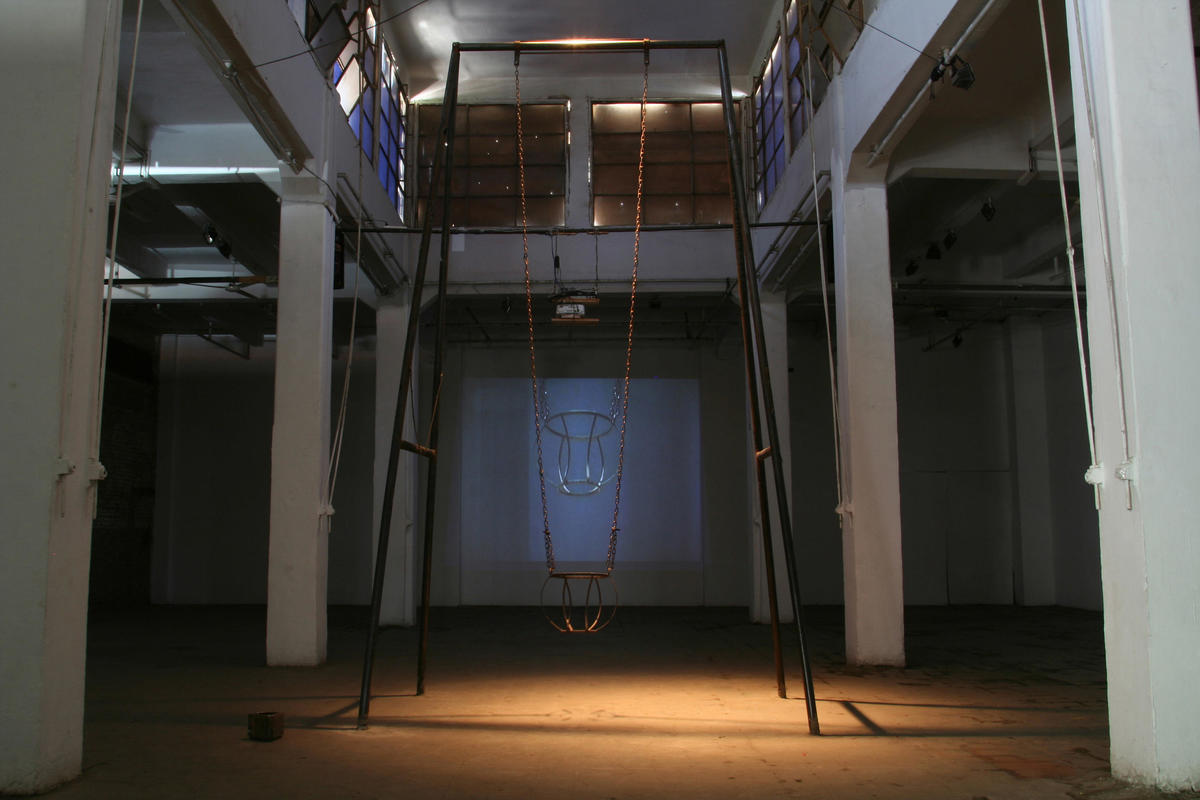
Cairo
Ayman Ramadan: Hekaya
Townhouse Gallery
June 8-30, 2008
Artist Ayman Ramadan’s personal story (hekaya, in Arabic) is one that critics, curators, friends of Townhouse Gallery, and, perhaps not least, Ramadan himself all love to tell. Born in a small village outside of Cairo, Ramadan came to the Egyptian capital more than a decade ago. He has worked myriad jobs ever since — from microbus ticket vendor, coffee boy, and car mechanic to security guard at a certain downtown gallery. The Townhouse community proved to be a nurturing one — so much so that in 2001, Ramadan, who had had no formal art training to speak of, held his first exhibition there.
From the start, Ramadan’s singular biography has intersected with his work in multiple ways; he’s managed to bring the dusty reality of Cairo’s backstreets into the gallery space. Projects such as Baladi Bus, Coffee Shop, and Iftar (all 2004) offered the viewer a slice of Egyptian life that was an alternative to the postcard perfection of pyramids and the grandeur of a mythologized past. These works captured the urban, political, psychosocial, and religious complexities of working-class Cairo.
Installations such as A Downtown Street and The Waiting Room (both 2002) stressed the invisibility of the lower classes in stark yet subtle, often beautiful, sculptural forms fashioned from spare car parts. The recycling of automotive detritus into a social and artistic statement exemplified how the sculptural enacts material presence and how material “speaks” beyond its mimetic representation.
In the case of Ramadan’s crude metal figures — at first glance anonymous and uniform, yet never lacking individual qualities — the suspension of upward social mobility was literally inscribed in the sculptures’ poses. At the same time, inertia was performed by the use of rusty scrap metal as medium and matter.
In Ramadan’s most recent exhibition at Townhouse, ‘Hekaya,’ the artist combined video with the physical, sculptural component. While many of Ramadan’s previous installations were mixed-media in nature, his title piece signaled development and maturity in terms of content and aesthetics. It alleviated the crowdedness of earlier projects and moved toward the metaphorical, with Ramadan diverting human subjectivity to the realm of the imaginary. As a result, location and temporality became unspecified, creating more space for the viewer’s interpretation.
Made after a year of study at the Academy of Art in San Francisco, ‘Hekaya’ was a bleak minimalist piece. Rather than engendering participation or empathy that was so central to works such as Baladi Bus, Coffee Shop, or Koshary min Zamman (2006), ‘Hekaya’ instead inspired a sense of contemplation and introspection.
The installation consisted of a rusted swing hanging five meters high in the center of the gallery. A spotlight pointed to its cage-like seat, creating an eerie shadow play. In the background, a looped video projection showed the swing swaying in solitude. Bathed in darkness, the huge construction appeared menacing and intimidating and was anything but a cheerful recollection of childhood. Though it was amplified in scale and more closely resembled an elaborate torture device than a playground toy, the residue of memory still clung to the swing and faintly suggested a time when life may have been happy, even uncomplicated.
The soundtrack, a recording of creaking swings and muffled conversation in a Cairo playground, was far too loud and repetitive. It felt like a superfluous add-on and, unfortunately, distracted from the ambiguous character of the swing, which visually operated simultaneously as a plaything devoid of functionality, a vehicle of collective and individual memory, and the seat of an uncertain future.
The swings had become a sculptural object in the gallery space. Its uprootedness was further denoted by the word hekaya, carved in Arabic on one of its hinges. It was as if this act of naming ensured and validated the singularity of the piece, transforming it into something verging on the monumental. Indeed, the swing became the inert materialization of loss, albeit undefined and unarticulated. This sense of loss heightened by the contrast between the stasis of the actual swing and the video showing the swing in motion. Movement, mobility, and change did seem like possibilities, but they remained idle and unfulfilled.
The looped motion became a senseless one, mere mechanization, without a human subject on the swing to enjoy its workings.
In that respect, it was telling that Ramadan insisted on the singular use of hekaya, and not its plural, hekayaat. It was as if the artist were telling us that there is but one generic story we all find ourselves in eventually, in which the future is unpredictable and replete with promises it can’t keep.